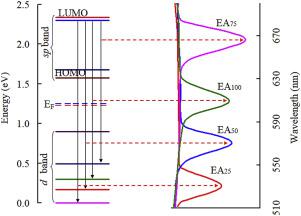Our official English website, www.x-mol.net, welcomes your
feedback! (Note: you will need to create a separate account there.)
Influence of gold ions on visible and NIR luminescence features of Er3+ ions in lead boroselenate glass ceramics
Journal of Luminescence ( IF 3.3 ) Pub Date : 2020-10-01 , DOI: 10.1016/j.jlumin.2020.117481 A. Siva Sesha Reddy , G. Lakshminarayana , N. Purnachand , Valluri Ravi Kumar , N. Venkatramaiah , V. Ravi Kumar , N. Veeraiah
Journal of Luminescence ( IF 3.3 ) Pub Date : 2020-10-01 , DOI: 10.1016/j.jlumin.2020.117481 A. Siva Sesha Reddy , G. Lakshminarayana , N. Purnachand , Valluri Ravi Kumar , N. Venkatramaiah , V. Ravi Kumar , N. Veeraiah

|
Abstract This work is focused on the amplification of green (G), orange (O) and NIR (1.5 μm) emissions of Er3+ ions by co-doping with varying contents (traces ≤ 0.1 mol%) of Au2O3 in an exotic PbO-B2O3-SeO2 glasses ceramic. The glasses were synthesized by conventional melt quenching method and were crystallized by heat-treating them at crystallization temperature for a period of 24 h. Initial characterization of the samples by means of SEM, XRD, XPS, IR and Raman studies suggested that the post-heated samples are entrenched with poly-crystal grains (with sizes varying from 100 to 500 nm). These studies have also revealed that the concentration of such nano-crystallites is increased with increased content of Au2O3 up to 0.075 mol%. The XRD studies, in particular, have indicated that the glass ceramics are composed of Au2(SeO3)2(SeO4) (crystal phase containing Se ions of mixed valence states) and Au0 nano particles. The XPS studies have also indicated the presence of Se and gold ions in different valence states in these samples. IR and Raman spectra have suggested increased degree of internal chaos in the glass ceramic with increasing concentration of Au2O3. Optical absorption (OA) spectra of Au2O3 doped glass ceramic samples (without Er3+ ions) exhibited a broad band in the visible region identified as surface plasmon resonance (SPR) band of gold metallic particles. The photoluminescence (PL) spectra of these samples exhibited an emission peak due to inter-band transition from sp to d energy bands of Au0 metallic particles. This emission is identified to play a crucial role in enhancing PL emission of Er3+ ions in the visible and NIR regions. Finally, we have recorded optical absorption, photoluminescence spectra and decay profiles of the Er3+ doped (with Au2O3 as co-dopant) glass ceramics. The spectra were characterized using J–O theory and different radiative parameters (viz., transition probabilities, branching ratios, radiative lifetime) of green, orange and NIR emission transitions of Er3+ ions were evaluated. The results indicated a significant reinforcement of green (4S3/2 → 4I15/2), orange (4F9/2 → 4I15/2) and NIR (4I13/2 → 4I15/2) emissions of Er3+ ions due to co-doping with Au2O3. Quantitative analysis of the results of PL emission indicated that 0.075 mol% of Au2O3 is the optimal concentration for achieving the highest quantum yield of these three emissions in this glass ceramic. Additional population of 4S3/2, 4F9/2 and 4I13/2 energy levels of Er3+ ions from the excited state of Au0 metallic particles is found to be the reason for such enhancement of quantum efficiency.
更新日期:2020-10-01











































 京公网安备 11010802027423号
京公网安备 11010802027423号